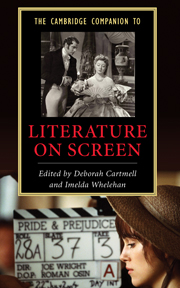Introduction - Literature on screen: a synoptic view
Published online by Cambridge University Press: 28 September 2007
Summary
The publication of The Cambridge Companion to Literature on Screen confirms the fact that Literature on Screen has finally arrived. Always a “hybrid” subject, literature on screen was too literary for film studies and too film-based for Literary Studies, and has tended to occupy an uneasy place between the two, perhaps tending towards departments of literature in the main. Literary adaptations have been the subject of much academic discourse in both fields (auteur studies, and Shakespeare on Screen texts are two obvious examples), but until the last decade there have been few attempts to evaluate the process of adaptation itself and even then only some of these investigations attempt to theorize the textual transactions that occur in the process - whether in the mind of the adaptor, the critic, or the reader/viewer.
As early as 1936, Renaissance scholar Allardyce Nicoll, in Theatre and Film, considers the potential of film to merit the same status as theatrical texts, while conversely reflecting on how film fails to achieve its potential when it simply copies, or “culls” from literature. Like Nicoll, George Bluestone in 1957, in the first book-length study of adaptation, Novels into Film, alludes to Gotthold Ephraim Lessing's essay The Laocoon (1766), on the differentiations between poetry and painting.
- Type
- Chapter
- Information
- The Cambridge Companion to Literature on Screen , pp. 1 - 12Publisher: Cambridge University PressPrint publication year: 2007
- 18
- Cited by

